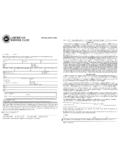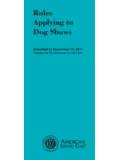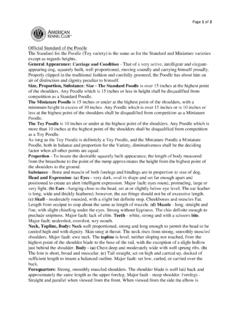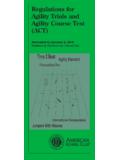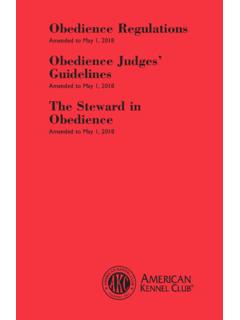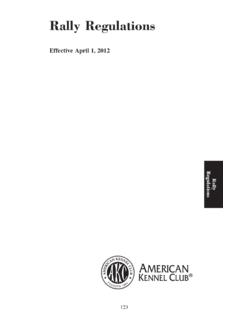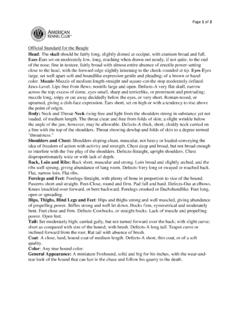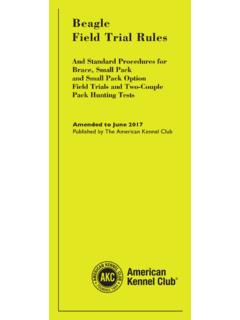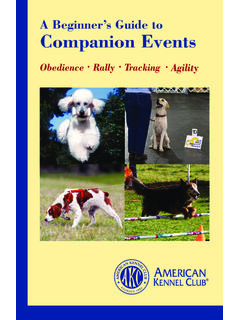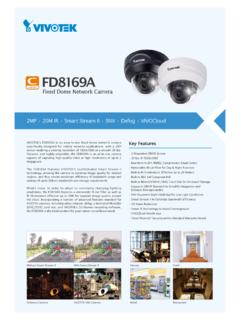Transcription of Page 1 of 3 - American Kennel Club
1 Page 1 of 3. Official Standard of the great Dane General Appearance: The great Dane combines, in its regal appearance, dignity, strength and elegance with great size and a powerful, well-formed, smoothly muscled body. It is one of the giant working breeds, but is unique in that its general conformation must be so well balanced that it never appears clumsy and shall move with a long reach and powerful drive. It is always a unit-the Apollo of dogs. A. great Dane must be spirited, courageous, never timid; always friendly and dependable. This physical and mental combination is the characteristic which gives the great Dane the majesty possessed by no other breed. It is particularly true of this breed that there is an impression of great masculinity in dogs, as compared to an impression of femininity in bitches.
2 Lack of true Dane breed type, as defined in this standard, is the most serious fault. Size, Proportion, Substance: The male should appear more massive throughout than the bitch, with larger frame and heavier bone. In the ratio between length and height, the great Dane should be square. In bitches, a somewhat longer body is permissible, providing she is well proportioned to her height. Coarseness or lack of substance are equally undesirable. The male shall not be less than 30 inches at the shoulders, but it is preferable that he be 32 inches or more, providing he is well proportioned to his height. The female shall not be less than 28 inches at the shoulders, but it is preferable that she be 30.
3 Inches or more, providing she is well proportioned to her height. Danes under minimum height must be disqualified. Head: The head shall be rectangular, long, distinguished, expressive and finely chiseled, especially below the eyes. Seen from the side, the Dane's forehead must be sharply set off from the bridge of the nose, (a strongly pronounced stop). The plane of the skull and the plane of the muzzle must be straight and parallel to one another. The skull plane under and to the inner point of the eye must slope without any bony protuberance in a smooth line to a full square jaw with a deep muzzle (fluttering lips are undesirable). The masculinity of the male is very pronounced in structural appearance of the head.
4 The bitch's head is more delicately formed. Seen from the top, the skull should have parallel sides and the bridge of the nose should be as broad as possible. The cheek muscles should not be prominent. The length from the tip of the nose to the center of the stop should be equal to the length from the center of the stop to the rear of the slightly developed occiput. The head should be angular from all sides and should have flat planes with dimensions in proportion to the size of the Dane. Whiskers may be trimmed or left natural. Eyes shall be medium size, deep set and dark, with a lively intelligent expression. The eyelids are almond shaped and relatively tight, with well-developed brows.
5 Haws and Mongolian eye(s) are very serious faults. In Harlequins and Merles, the eyes should be dark, but blue eye(s) and eyes of different colors are permitted. Ears shall be high set, medium in size and of moderate thickness, folded forward close to the cheek. The top line of the folded ear should be level with the skull. If cropped, the ear length is in proportion to the size of the head and the ears are carried uniformly erect. Nose shall be black, except in the blue Dane, where it is a dark blue-black. A black spotted nose is permitted on the Harlequins and Merles; a solid pink color nose is not desirable. A split nose is a disqualification. Teeth shall be strong, well-developed, clean and with full dentition preferred.
6 The incisors of the lower jaw touch very lightly the bottoms of the inner surface of the upper incisors (scissors bite). An overshot bite is a serious fault. Undershot and wry mouths are very serious faults. Even bites, misaligned or crowded incisors are minor faults. Neck, Topline, Body: The neck shall be firm, high set, well arched, long and muscular. From the nape, it should gradually broaden and flow smoothly into the withers. The neck underline should be clean. Withers shall slope smoothly into a short level back with a broad loin. The chest shall be broad, deep and well muscled. The forechest should be well developed without a pronounced sternum. The brisket extends to the elbow, with well sprung ribs.
7 The body underline should be tightly muscled with a well-defined Page 2 of 3. tuck-up. The croup should be broad and very slightly sloping. The tail should be set high and smoothly into the croup, but not quite level with the back, a continuation of the spine. The tail should be broad at the base, tapering uniformly down to the hock joint. At rest, the tail should fall straight. When excited or running, it may curve slightly, but never above the level of the back. A ring or hooked tail is a serious fault. A docked tail is a disqualification. Forequarters: The forequarters, viewed from the side, shall be strong and muscular. The shoulder blade must be strong and sloping, forming, as near as possible, a right angle in its articulation with the upper arm.
8 A line from the upper tip of the shoulder to the back of the elbow joint should be perpendicular. The ligaments and muscles holding the shoulder blade to the rib cage must be well developed, firm and securely attached to prevent loose shoulders. The shoulder blade and the upper arm should be the same length. The elbow should be one-half the distance from the withers to the ground. The strong pasterns should slope slightly. The feet should be round and compact with well-arched toes, neither toeing in, toeing out, nor rolling to the inside or outside. The nails should be short, strong and as dark as possible, except that they may be lighter in Harlequins, Mantles and Merles.
9 Dewclaws may or may not be removed. Hindquarters: The hindquarters shall be strong, broad, muscular and well angulated, with well let down hocks. Seen from the rear, the hock joints appear to be perfectly straight, turned neither toward the inside nor toward the outside. The rear feet should be round and compact, with well-arched toes, neither toeing in nor out. The nails should be short, strong and as dark as possible, except they may be lighter in Harlequins, Mantles and Merles. Wolf claws are a serious fault. Coat: The coat shall be short, thick and clean with a smooth glossy appearance. Color, Markings and Patterns: Brindle Color: The base color shall be yellow gold and always be brindled with black cross stripes.
10 Patterns/Markings: Brindle shall have a black chevron pattern with a black mask. Black should appear on the eye rims and eyebrows and may appear on the ears and tail tip. The more intense the base color and the more distinct and evenly brindled, the more preferred will be the color. Too much or too little brindling are equally undesirable. White markings on the chest or toes; black fronted; dirty colored Brindles; are not desirable. Fawn Color: The color shall be yellow gold. Patterns/Markings: Black should appear on the eye rims and eyebrows with a black mask and may appear on the ears and tail tip. Deep yellow gold must always be given the preference. White markings on the chest or toes, black-fronted; dirty colored Fawns; are not desirable.
